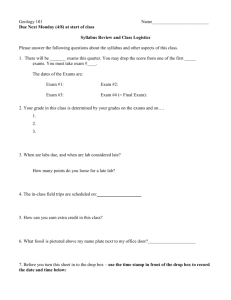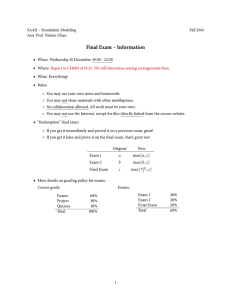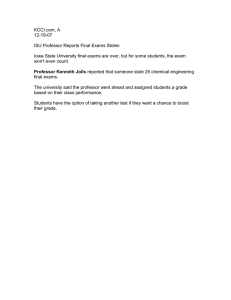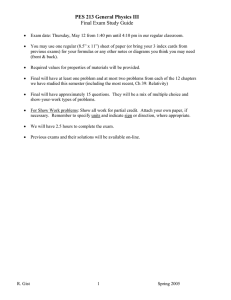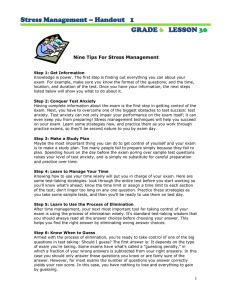Assessing Level and Causes of Exam Stress among University Students... Mediterranean Journal of Social Sciences Dr. Samina Malik MCSER Publishing, Rome-Italy
advertisement
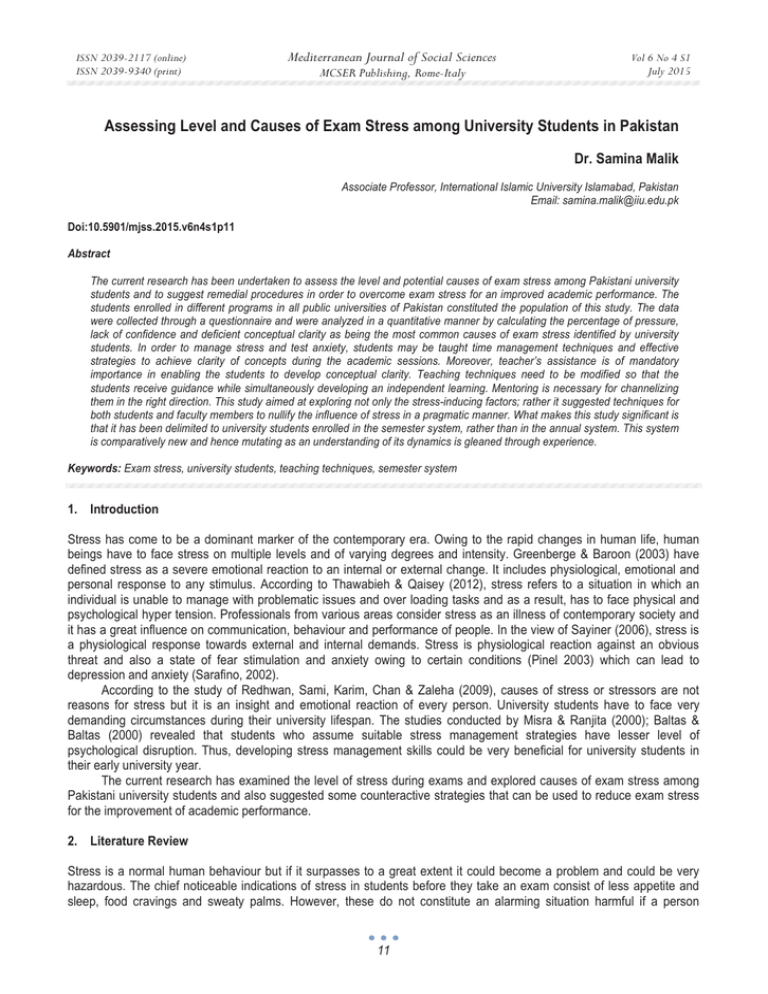
ISSN 2039-2117 (online) ISSN 2039-9340 (print) Mediterranean Journal of Social Sciences MCSER Publishing, Rome-Italy Vol 6 No 4 S1 July 2015 Assessing Level and Causes of Exam Stress among University Students in Pakistan Dr. Samina Malik Associate Professor, International Islamic University Islamabad, Pakistan Email: samina.malik@iiu.edu.pk Doi:10.5901/mjss.2015.v6n4s1p11 Abstract The current research has been undertaken to assess the level and potential causes of exam stress among Pakistani university students and to suggest remedial procedures in order to overcome exam stress for an improved academic performance. The students enrolled in different programs in all public universities of Pakistan constituted the population of this study. The data were collected through a questionnaire and were analyzed in a quantitative manner by calculating the percentage of pressure, lack of confidence and deficient conceptual clarity as being the most common causes of exam stress identified by university students. In order to manage stress and test anxiety, students may be taught time management techniques and effective strategies to achieve clarity of concepts during the academic sessions. Moreover, teacher’s assistance is of mandatory importance in enabling the students to develop conceptual clarity. Teaching techniques need to be modified so that the students receive guidance while simultaneously developing an independent learning. Mentoring is necessary for channelizing them in the right direction. This study aimed at exploring not only the stress-inducing factors; rather it suggested techniques for both students and faculty members to nullify the influence of stress in a pragmatic manner. What makes this study significant is that it has been delimited to university students enrolled in the semester system, rather than in the annual system. This system is comparatively new and hence mutating as an understanding of its dynamics is gleaned through experience. Keywords: Exam stress, university students, teaching techniques, semester system 1. Introduction Stress has come to be a dominant marker of the contemporary era. Owing to the rapid changes in human life, human beings have to face stress on multiple levels and of varying degrees and intensity. Greenberge & Baroon (2003) have defined stress as a severe emotional reaction to an internal or external change. It includes physiological, emotional and personal response to any stimulus. According to Thawabieh & Qaisey (2012), stress refers to a situation in which an individual is unable to manage with problematic issues and over loading tasks and as a result, has to face physical and psychological hyper tension. Professionals from various areas consider stress as an illness of contemporary society and it has a great influence on communication, behaviour and performance of people. In the view of Sayiner (2006), stress is a physiological response towards external and internal demands. Stress is physiological reaction against an obvious threat and also a state of fear stimulation and anxiety owing to certain conditions (Pinel 2003) which can lead to depression and anxiety (Sarafino, 2002). According to the study of Redhwan, Sami, Karim, Chan & Zaleha (2009), causes of stress or stressors are not reasons for stress but it is an insight and emotional reaction of every person. University students have to face very demanding circumstances during their university lifespan. The studies conducted by Misra & Ranjita (2000); Baltas & Baltas (2000) revealed that students who assume suitable stress management strategies have lesser level of psychological disruption. Thus, developing stress management skills could be very beneficial for university students in their early university year. The current research has examined the level of stress during exams and explored causes of exam stress among Pakistani university students and also suggested some counteractive strategies that can be used to reduce exam stress for the improvement of academic performance. 2. Literature Review Stress is a normal human behaviour but if it surpasses to a great extent it could become a problem and could be very hazardous. The chief noticeable indications of stress in students before they take an exam consist of less appetite and sleep, food cravings and sweaty palms. However, these do not constitute an alarming situation harmful if a person 11 ISSN 2039-2117 (online) ISSN 2039-9340 (print) Mediterranean Journal of Social Sciences MCSER Publishing, Rome-Italy Vol 6 No 4 S1 July 2015 experiencing such symptoms. Existing literature has discovered that stress is the chief factor of low performance of students as some students complain that their minds go blank during examinations (Latifa & Safan, 2012). This study has brought within its purview the major sources of stress as enunciated below; 2.1 Sources of Stress Sayiner (2006) identified two main sources of stress in his study these are: 2.1.1 Environmental Factors Environmental factors which cause stress include economic, environmental, political and technical uncertainties. 2.1.2 Individual Factors Due to individual differences for instance personality, economic conditions and family background the type and level of stress differs in every individual. According to Baltas & Baltas (2000), social support, perception, hostility and locus of control are individual factors of stress. Various studies have analysed the causes and factors of exam stress confronted by students like Hamaideh (2011) investigated stress its causes and reactions thus computing them against various factors through a research study on university students. Gender and demographic factors such as urban and rural background of students can also cause stress in students (Tajularipin, Vizata & Saifuddin, 2009). According to Laurence, Williams & Eiland (2009) major depression indications in students include fear of exams, failures and low level of self-esteem during leisure activities. In this context, Wong, Cheung, Chan & Tang (2006) conducted an online survey study and identified moderate and severe levels of stress, anxiety and depression in first year university students. In recent years exam stress has become an emerging and critical problem for university students. Exam stress can disturb students’ learning and their test performance but higher level of stress may even cause illness (Scot, 2008). In the view of Zeidner (1998), anxiety and exam stress are intellectual and emotional reaction of an individual due to the fear of adverse consequences. Mayya, Rao & Ramnarayan (2004) stated difficult syllabus and improper instructional methods are the key reasons behind stress among students because they have to maintain their academic performance. Therefore, when they think themselves unfit to perform according to any self-imposed or externally required criterion, they come under stress. Likewise, personal and family oriented issues also lead to exam stress. Mc Donald (2001) identified the most common reasons of stress like poor study habits, lack of exam preparation and organization, the failure to adjust time and studying a night before an exam. Getting worried about competition and anticipated results, past performances in exams, academic probation are also some other reasons of test anxiety in students. This stress can be severe if the past experiences, performances and beliefs of student are not good. Eggen & Kauchak (1999) viewed identification of prompting factors, causes of academic performance and achievement of students as a key goal of educational researchers. Majority of researchers have viewed exam stress as a chief factor disturbing learners’ academic performance (Musch & Broder, 1999). Managing time is a dynamic factor for academic accomplishment in university students. Mostly, university students have very busy timetables because they have to attend classes, meet deadlines for assignments, exam preparation, along with co-curricular, social and personal activities. Inability of time management and making a balance in all activities is the chief source of stress for university students (Zeidner, 1998). Variation in blood pressure is also a common indication during stress. Moreover, one may also notice an effect on hormonal and immune systems of the human body under emotional pressure stemming from test anxiety. Numerous psychological studies have also reported a high stress level in females during exams as compared to their male counterparts. According to Barlett (1998), stress intensely affects mental and emotional health of a person. Stress also induces stomach instability that can cause ulcer (Ogden, 2000). In the context of Pakistani society, parents and teachers have a potential assertiveness of laying pressure on students for getting good grades in an exam. This condition can be very intimidating for students if they fail to meet the anticipations of parents, teachers and the society in general. Thus, academic success causes high degree of stress in students (Fariza, 2005). Mates & Alisson (1992) proposed suitable instructional and learning approaches to decrease stress among students. They stated that such kind of a curriculum that emphasizes only on academic achievement should be revised to prevent stress in students. Sansgiry, Bhosle & Sail (2006) also suggested that attitude modification of students, fostering the ability to envisage success, positive thinking and anticipations, planned and proper exam preparation can be very helpful to control exam stress and anxiety. 12 ISSN 2039-2117 (online) ISSN 2039-9340 (print) Mediterranean Journal of Social Sciences MCSER Publishing, Rome-Italy Vol 6 No 4 S1 July 2015 Examinations are frequently used to appraise the academic ability of the students in university's education system. Instructors are, however, cognizant of the fact that it is a matter of deep stress for university students and has adverse effects on their academic achievement. A high level of stress can be harmful to students’ academic success. Such types of examinations do not measure students’ genuine knowledge and abilities. There should be some other less stressful ways to evaluate students’ and talents abilities. Parsons (2008) conducted a survey on university students and discovered exam stress as a major problem for students. It is further marked by various studies that stress is the most common problem in lower ability students. Moreover, lack of preparation for exams is another reason behind anxiety in students; however, such kind of students should not be provided much sympathy. Symptoms of stress can be examined in students during examinations. Some students complain of their minds becoming blank and vacuous. Some stressed out students tend to ask too many questions from the examiner, wasting time to write the perfect answer, feeling unwell, asking to defer the exam etc. These are some of the signs that can be observed during examinations. An overview of the existing literature also shows some other indications of stress like feeling anxious, gazing into space, working too fast but wrongly, working very slowly but properly, postponing assignments, depression over past failures, procrastination in studies and feeling helpless over an uncertain future. Some physiological indications can also be observed like increased respiration and heartbeats, heightened muscle tension, blood pressure and gastric discomfort (Parson, 2008). However, some anxiety alleviation tactics devised on the part of the teacher can monumentally help in managing stress. A proper division of marks vis-à-vis the weightage assigned to assignments and the final projects, attempting practice questions before the final examination and assessment, confidence building measures, reflective activities, inculcating skills for managing exam questions, proceeding from easy to complex difficulty level, providing sufficient choice in the question paper, allowing ample time for exam, projects and assignments can alleviate test anxiety among students. Some universities like Stanford University, University of Maryland School of Medicine, Georgetown University and University of Massachusetts Medical School introduced anxiety and stress reduction exercises for students to lessen stress and focused on enhancing stress management skills. A longitudinal study conducted by Paul, Elam & Verhulst (2007) on university students suggested deep breathing meditation technique as a powerful tool for stress alleviation. 3. Research Methodology 3.1 Objectives The current research has been undertaken to assess the causes and level of exam stress among university students of Pakistan and to suggest remedial procedures for both students and faculty members to overcome exam stress for a better academic performance. 3.2 Population and Sampling The students enrolled in different programs in all public universities of Pakistan where semester system is followed constituted the population of this study. Through convenient sampling technique 450 students studying at bachelors and masters level in public sector universities of Islamabad were selected for data collection. 3.3 Research Instrument The instrument for the study was developed by the researcher after thorough study of pertinent literature accessible to her. It comprised of 2 parts: one measuring the level of exam stress containing 68 statements related to their feelings during the exams and the other part assessing the causes of this stress containing 41 items covering 10 variables, which included; 1. Improper teaching methods 2. Difficult syllabus 3. Inability to manage time 4. Past performance 5. Competition, anticipated result and fear of failure 6. Course Load 7. Family and society expectations 13 Mediterranean Journal of Social Sciences ISSN 2039-2117 (online) ISSN 2039-9340 (print) Vol 6 No 4 S1 July 2015 MCSER Publishing, Rome-Italy 8. Financial position 9. Lack of exam preparation/ study habits and 10. Poor physical and emotional health The options given for each item were Never, Rarely, Some Times, Often, and Very Often. The students were supposed to mark the most relevant choice according to their personal judgments. The collected data were then fed into SPSS version 15 for analysis. The data were analyzed by computing Descriptive Statistics (Frequency, Percentage, Mean and Std. Deviation). 4. Analysis Result 4.1 Level of Exam Stress among University Students The analysis of level of exam stress was based on percentages students experiencing each level of stress. There are 5 categories of exam stress named as low, low to moderate, moderate, moderate to high and high level of stress. Table 1: Level of Exam Stress of the Students Groups 131-160 161-190 191-220 221-250 251-280 Total Stress Level Low level Low to moderate level Moderate level Moderate to high level High level Frequency 33 132 141 111 33 450 Percent 7.3% 29.3% 31.3% 24.7% 7.3% 100.0% Table 1 demonstrates data about exam stress of students. The data is dividing the whole group of students in five groups according to their level of stress. In the top and lower group the number of students is equal, that is 33 (7.3 %) students in both groups. In the second and forth group the number of students 132 and 111 (29.3 and 24.7 %) respectively. Majority of the students 141 (31.3%) students lie in the middle group. It reveals that most of students fall in the “moderate level” of stress followed by “low to moderate level”. The analysis reveals that the situation of students appeals consideration on the part of students, teachers and administrators. 4.2 Causes of Exam Stress among University Students The second part of the questionnaire was related to causes of exam stress among university students. Analysis was done by calculating mean and standard deviation. Table 2: Improper Teaching Methods Statements Lack of attention Fear of scared Feel boring during class Lack of understanding N 450 450 450 450 Mean 2.78 1.88 1.87 1.81 Std. Deviation 1.067 1.279 1.145 1.041 Table 2 shows data about improper teaching method. The statistics shows that majority of the students cannot pay attention in class. Table 3: Difficult Syllabus Statements Difficult course Unable to understand different concepts of the course 14 N 450 450 Mean 3.67 3.08 Std. Deviation 1.487 1.881 Mediterranean Journal of Social Sciences ISSN 2039-2117 (online) ISSN 2039-9340 (print) Vol 6 No 4 S1 July 2015 MCSER Publishing, Rome-Italy Table 3 Shows that students sometimes felt that their course was difficult and they were unable to understand different concepts of the syllabus. Table 4: Inability to Manage Time Statements Cannot find enough time for exercise/activities Unable to meet deadlines Cannot find enough time to Study N 450 450 450 Mean 4.36 2.29 1.89 Std. Deviation .534 1.534 .845 Table 4 shows that majority of the students felt inability to manage their time and often cannot find enough time for exercise/activities. Table 5: Past Performance Statements Unable to perform well in exams Fear of attending such activity or participation based classes Poor participation in class discussion Previous results are poor Often late for class Unable to answer teachers’ questioning Poor test scores Poor attendance N 450 450 450 450 450 450 450 450 Mean 4.09 4.08 4.01 3.81 3.01 2.36 2.20 2.07 Std. Deviation .962 .807 .980 .849 .976 .900 .934 .913 Table 5 shows that majority of the students sometimes come late in the class, have poor participation in class discussion, have poor previous results, have fear of attending such activity or participation based classes and unable to perform well in exams. The most dominating indicator related to past performance which causes stress is inability of students to perform well in exams. Table 6: Competition, Anticipated Result and Fear of Failure Statements Lack of self confidence Fear of tests Insecurity because of competition Fear of test results N 450 450 450 450 Mean 4.15 3.49 2.48 2.34 Std. Deviation .649 .974 1.021 1.035 Table 6 shows that majority of the students are suffering from lack of self-confidence and they are frightened by hearing the announcement of a test. Table 7: Course Load Statements Need for tuition Too much assignments N 450 450 Mean 3.96 3.59 Std. Deviation .842 .686 Table 7 shows that majority of the students feel the need for tuition and they have too many assignments to do. Table 8: Family and Society Expectations Statements Parents expect higher grades N 450 Mean 2.71 Std. Deviation 1.064 Table 8 shows that students claim that their parents rarely expect high grades from them. So family expectations are not 15 ISSN 2039-2117 (online) ISSN 2039-9340 (print) Mediterranean Journal of Social Sciences Vol 6 No 4 S1 July 2015 MCSER Publishing, Rome-Italy stress enhancers. Table 9: Financial Position Statements Financial problems to pay basic expenses Less pocket money Parents control all the student’s expenses N 450 450 450 Mean 4.29 4.15 3.84 Std. Deviation .765 .918 1.124 Table 9 shows that majority of the students often face financial problems. They have face financial problems to pay basic expenses less pocket money and their parents control all of their expenses. Table 10: Lack of Exam Preparation/Study Habits Statements Study only during Exams Unable to complete Exam preparations till exams Study one night before exams Study regularly Study one month before exams N 450 450 450 450 450 Mean 3.29 3.21 3.21 2.81 2.78 Std. Deviation .790 .822 .710 .999 1.061 Table 10 shows that majority of the students study during exams or one night before exams and they are unable to complete exam preparation till end or the start of exams. Table 11: Poor Physical and Emotional Health Statements Lost weight during exams Change in sleeping habits Depression Feel lonely and isolated N 450 450 450 450 Mean 3.18 3.15 3.03 2.85 Std. Deviation .760 .663 .806 .979 Table 11 shows that majority of the students lost weight during exams, their sleeping habits got changed during exams and they felt depression. Table 12: Overall Causes of Exam Stress Variables Financial position Course load Difficult syllabus Past performance Competition, anticipated result and fear of failure Lack of exam preparation/study habits Poor physical and emotional health Inability to manage time Parents and family expectations Improper teaching methods N 450 450 450 450 450 450 450 450 450 450 Mean 4.093 3.775 3.375 3.20375 3.115 3.06 3.052 2.846 2.71 2.085 Std. Deviation 1.23450 1.21256 2.30897 3.25132 1.96489 2.37703 3.96789 2.06482 1.064 2.22151 Table 12 illustrates the variable indicating the causes of exam stress. Mean values show that financial factors, course Load, difficult syllabus, past performance, competition, anticipated result, fear of failure, lack of exam preparation/study habits and poor physical and emotional health are the most important stress factors in students life. 16 ISSN 2039-2117 (online) ISSN 2039-9340 (print) Mediterranean Journal of Social Sciences MCSER Publishing, Rome-Italy Vol 6 No 4 S1 July 2015 5. Discussion and Recommendations As the results of study revealed that most of students fall in the “moderate level” of stress followed by “moderate to high level”, so this situation of students requires consideration on the part of students, teachers and administrators. The researcher has identified few techniques to manage stress and test anxiety like students may be taught time management techniques and acquisition of clarity of concepts during the academic sessions. Moreover, teacher assistance is of mandatory importance in enabling the students to develop conceptual clarity. Teaching techniques need to be modified so that the students receive guidance while simultaneously developing an independent learning. Mentoring is necessary for channelizing them in the right direction. Majority of the students cannot pay attention in class which requires consideration on the part of both students and teachers. The syllabus may be made comprehendible and interesting using different teaching techniques and strategies. Students have also shown concern about their inability to manage their time and often cannot find enough time for exercise/activities which is a special feature of semester system for which special orientation may be arranged and students may be guided more about managing their time according to demands of their learning, which in turn would be enhancing their ability to perform well in exams. Another important concern of students is transition from annual system to semester system and majority of the students study during exams or one night before exams and they are unable to complete exam preparation till end or the start of exams so there is a need to transform their study habits according to demands of semester system. References Baltas, Z., & Baltas, A. (2000). Stress and Coping with Stress (20th ed.). Remzi Press. Bartlett, D. (1998). Stress. Buckingham: Open University Press. Eggen, P., & Kauchak, D. (1999). Educational psychology. Upper Saddle River, N.J.: Merrill. Scott, M.S. (2008): Test Anxiety: How To Deal With Test Anxiety and Actually Do Better On Tests,You CAN Reduce Test Anxiety! By About.com Health's Disease and Condition content is reviewed by the Medical Review Board. The Academic Skills Center (2010): Student Academic Services, at Cal Poly San Luis ObispoA, 2011-Anastasia & Steve http://www.planetofsuccess.com/ blog/author/Ad min/ Sham, F. (2005). Emotional stress Islamic Youth. International Journal of Islamic Studies, 7(1), 3-24. Retrieved from http://translate. google.com.pk/translate?hl=en&sl=ms&u=http://www.ukm.my/ijis/Abstrak/27-1-1.html&prev=search Green, S. (2001), Health Psychology: A Textbook, 2nd edition by Jane Ogden. Open University Press, Buckingham. Greenberg, J., & Baron, R. (2003). Behavior in organizations. Upper Saddle River, NJ: Prentice Hall. Hamaideh, S. (2011). Stressors and Reactions to Stressors among University Students. International Journal of Social Psychiatry, 57(1), 69-80. doi:10.1177/0020764010348442 Latifa, T., Aziz, A., Nermin, M., & Sanaa, M. (2012). Test anxiety, and Skills of Time Management among Faculty Nursing Students. Journal of American Science, 8(4). Laurence, B., Williams, C., & Eiland, D. (2009). Depressive Symptoms, Stress, and Social Support among Dental Students at a Historically Black College and University. Journal of American College Health, 58(1), 56-63. doi:10.3200/jach.58.1.56-63 Mates, D & Alisson, R. (1992). Sources of Stress and Coping Responses of High School Students, Journal of Adolescence. 27; 461 475. Mayya, S., Rao, A., & Ramnarayan, K. (2004). Learning Approaches, learning Difficulties and Academic Performance of Undergraduate Students of Physiotherapy. The Internet Journal of Allied Health Science and Practice, 2(4), 1-6. Retrieved from http://www. uc.edu/psc/sh/SH_Test_Anxiety.htm McDonald, A. (2001). The Prevalence and Effects of Test Anxiety in School Children. Educational Psychology, 21(1), 89-101. doi:10.1080/01443410124641 Misra, & Ranjita (2000). College students’ academic stress and its relation to their anxiety, time management, and leisure satisfaction. American Journal of Health Studies, 16, 41-52. Musch, J., & Broder, A. (1999). Test anxiety versus academic skills: A comparison of two alternative models for predicting performance in a statistics exam. British Journal of Educational Psychology, 69(1), 105-116. doi:10.1348/000709999157608 Parsons, D. (2008). Is There an Alternative to Exams? - Examination Stress in Engineering Courses. International Journal of Engineering Education, 24(6). Paul, G., Elam, B., & Verhulst, S. (2007). A Longitudinal Study of Students' Perceptions of Using Deep Breathing Meditation to Reduce Testing Stresses. Teaching and Learning in Medicine, 19(3), 287-292. doi:10.1080/10401330701366754 Pinel, J. (2003). Biopsychology. Boston, Mass: Allyn and Bacon. Redhwan, A., Sami, A., Karim, A., Chan, R., & Zaleha, M. (2009). Stress and Coping Strategies among Management and Science University Students: A Qualitative Study. The International Medical Journal, 8 (2). Sansgiry, S. S., Bhosle, M., & Sail, K. (2006). Factors that Affect Academic Performance among Pharmacy Students. American Journal of Pharmaceutical Education, 70(5), 104. Sarafino, E. P. (2002). Health Psychology: Biopsychosocial Interactions. United States: John Wiley & Sons, INC. 17 ISSN 2039-2117 (online) ISSN 2039-9340 (print) Mediterranean Journal of Social Sciences MCSER Publishing, Rome-Italy Vol 6 No 4 S1 July 2015 Sayiner, B. (2006). Stress Level of University Students. østanbul Ticaret Üniversitesi Fen Bilimleri Dergisi, 5(10), 33-34. Retrieved from http://www.ticaret.edu.tr/uploads/Kutuphane/dergi/f10/M00134.pdf Tajularipin, S., Aminuddin, H., Vizata, M., & Saifuddin, K. (2009). The Level of Stress among Students in Urban and Rural Secondary Schools in Malaysia. European Journal of Social Sciences, 10(2), 179. Thawabieh, A., & Qaisy, L. (2012). Assessing Stress among University Students. American International Journal of Contemporary Research, 2(2). Wong, J., Cheung, E., Chan, K., Ma, K., & Tang, S. (2006). Web-based survey of depression, anxiety and stress in first-year tertiary education students in Hong Kong. Aust N Z J Psychiatry, 40(9), 777-782. doi:10.1111/j.1440-1614.2006.01883.x Zeidner, M. (1998). Test anxiety. New York: Kluwer Academic Publishers. 18
